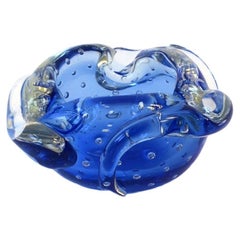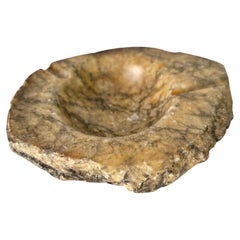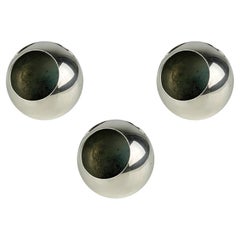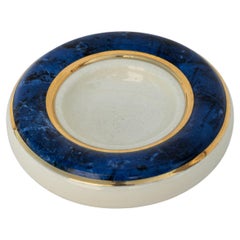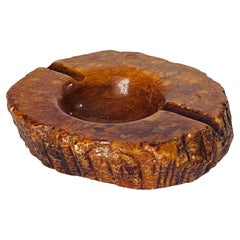Italian Ashtrays
to
239
1,136
65
1
2
1,133
65
5
639
404
5
25
26
106
186
221
26
4
757
63
61
43
1
1
1
1
1
706
528
236
205
180
882
219
1,958
1,201
285
279
239
1,201
1,145
1,169
40
35
31
30
25
Place of Origin: Italian
Italian Murano Blue Art Glass Ashtray or Bowl
By Seguso
Located in New York, NY
A small and beautiful Italian Murano art glass ashtray or bowl in the style of Seguso, circa mid-20th century, Italy. Bowl has a controlled bu...
Category
Mid-20th Century Mid-Century Modern Italian Ashtrays
Materials
Art Glass, Blown Glass, Murano Glass
Large Ashtray or Vide Poche in Marble Onyx in Green Color Italy 1960
Located in Auribeau sur Siagne, FR
Large Ashtray or Vide Poche in Marble Onyx in Green Color Italy 1960
Category
1960s Vintage Italian Ashtrays
Materials
Onyx, Marble
$331 Sale Price
20% Off
Mid Century Modern Murano Glass Ashtray in green Glass Italy 1960s
By Murano Glass Sommerso
Located in Palermo, PA
This vintage Murano ashtray is a unique find for collectors and lovers of Italian glass. Made from thick, hand-blown glass in a vibrant transparent green, it is shaped like a four-le...
Category
Mid-20th Century Mid-Century Modern Italian Ashtrays
Materials
Murano Glass
Silver-Plated Metal "unipersonale"ashtray from Lino Sabattini, 1972, set of 3
By Lino Sabattini, Sabattini Argenteria
Located in Varese, Lombardia
Set of 3 silver plated metal unipersonale ashtray by Lino sabattini, 1972. Manifacture's mark on the base.
Category
1970s Space Age Vintage Italian Ashtrays
Materials
Metal, Silver
Tommaso Barbi's ceramic tidy tray or ashtray, 1970s
By Tommaso Barbi
Located in Bastia Umbra, IT
Tommaso Barbi's ceramic emptying bowl or ashtray, 1970s, Made in Italy.
Beautiful round ceramic ashtray with a marble effect by Tommaso Barbi made in the 1970s. The attribution mark ...
Category
1970s Mid-Century Modern Vintage Italian Ashtrays
Materials
Ceramic
Large Ashtray or Vide Poche in Marble Onyx in Flash Brown Color Italy 1960
Located in Auribeau sur Siagne, FR
Large and rare vide poche in Onyx or Marble. This ashtray is rare by his color and size.
It is in a Brown color. It has been made in italy circa 1960.
Category
1960s Vintage Italian Ashtrays
Materials
Onyx, Marble
$331 Sale Price
20% Off
Lighter by Antonio Imperatore, blue murano glass, Italy, 1970
By Cristallerie Antonio Imperatore
Located in BARCELONA, ES
Superb magnifying lighter designed and produced by Antonio Imperatore in Italy in the 1970s. Blue Murano glass lighter with a magnifying effect on its facets, handcrafted by Venetian...
Category
1970s Hollywood Regency Vintage Italian Ashtrays
Materials
Crystal
Gucci Cestri e Nastri Porcelain Ashtray by Limoges
By Limoges, Gucci
Located in Miami, FL
Fine porcelain Gucci cigar ashtray from the 'Cestri e Nastri' (Baskets & Ribbons) collection. Made in France by Limoges. Decorated with a basket of fruit a...
Category
20th Century Italian Ashtrays
Materials
Porcelain
Studio O.P.I. for Gabbianelli Vintage Ceramic Green Ashtray 'New Old Stock'
By Studio O.P.I., Gabbianelli
Located in Landau an der Isar, Bayern
Large vintage green Italian ceramic ashtray designed by Studio O.P.I. for Gabbianelli Ceramiche, made in Milan, Italy, circa 1970. Rare find in original box - new old stock item.
Category
1970s Mid-Century Modern Vintage Italian Ashtrays
Materials
Ceramic
$621 Sale Price
30% Off
Hand-Painted Italian Metal Tray for Table or Wall
Located in Alessandria, Piemonte
Vintage Tuscan hand-painted metal tray. There is another one, very similar, by which there may be a pair of trays or wall decorations.
On disposal there is a black metal base/ little...
Category
1980s Beaux Arts Vintage Italian Ashtrays
Materials
Metal
Ceramic Whale Figurine Ashtray from Ceramica D'Arte, Salerno, Italy, 1970s
Located in Hamburg, DE
Ceramic Whale Figurine Ashtray from Ceramica D'Arte, Salerno, Italy, 1970s, in Very Good conditions. Designed 1970 to 1979 This piece has an attribution ...
Category
20th Century Italian Ashtrays
Materials
Ceramic
Italian mid century table ashtray by Gianni Moscatelli for Formanova, 1960s
By Formanova, Gianni Moscatelli
Located in MIlano, IT
Italian mid century table ashtray by Gianni Moscatelli for Formanova, 1960s
Round table ashtray, made of metal and plastic. Can be used as a pocket emptier or centerpiece.
Produced b...
Category
1960s Mid-Century Modern Vintage Italian Ashtrays
Materials
Metal
Round Ashtray or Vide-Poche in Terracotta by Fratelli Mannelli, Italy, 1970s
By Fratelli Mannelli
Located in Rome, IT
Rare ashtray or vide poche in ceramics terracotta and metal produced by Fratelli Mannelli in the 1970s, Italy.
The original label is still attached on the back, as shown in the p...
Category
1970s Mid-Century Modern Vintage Italian Ashtrays
Materials
Metal
Vintage Italian Bullicante Murano Glass Ashtray, 1970s
Located in Hamburg, DE
Vintage Italian Bullicante Murano Glass Ashtray, 1970s, in Very Good conditions. Designed 1970 to 1979
Additional information:
Materials: Glass
Color: Red
Period: 1970s
Country of O...
Category
20th Century Italian Ashtrays
Materials
Glass
Mid Century Blue Crystal Glass Ashtray, Italy, 1970s
Located in 05-080 Hornowek, PL
This original vintage glass ash tray bowl element was designed and produced in the 1970s in Lombardia, Italy. It is made in Crystal Cut Technique and has a fantastic faceted form. Th...
Category
Mid-20th Century Italian Ashtrays
Materials
Glass, Murano Glass
Sommerso Lighter by Seguso, Murano glass, Italy, 970
By Seguso
Located in BARCELONA, ES
Superb and rare sommerso lighter designed and manufactured for seguso in murano in the 1970s. Artisanal work of glass according to the "sommerso" technique (superposition of layers o...
Category
1970s Hollywood Regency Vintage Italian Ashtrays
Materials
Crystal
Large 2, 2 Kg Murano Glass "ORANGE" shell Bowl Element Vase Murano, Italy, 1970s
By Alessandro Mandruzzato, Flavio Poli
Located in Kirchlengern, DE
Article:
Murano glass bowl, shell element
Origin:
Murano, Italy
Decade:
1970s
This original vintage glass element was produced in the 1970s in Murano, Italy...
Category
Late 20th Century Mid-Century Modern Italian Ashtrays
Materials
Murano Glass
$1,373 Sale Price
20% Off
Italian White Marble Bowl / Ashtray, circa 1975
By Angelo Mangiarotti, Sergio Asti
Located in San Juan Capistrano, CA
Italian White Marble Bowl / Ashtray, circa 1975.
Category
20th Century Mid-Century Modern Italian Ashtrays
Materials
Marble
$187 Sale Price
25% Off
Barovier Toso Murano Jade Green Gold Flecks Italian Art Glass Spike Bowl Ashtray
By Ercole Barovier, Barovier&Toso
Located in Kissimmee, FL
Beautiful vintage Murano hand blown jade green and gold flecks Italian art glass ribbed with spike corners bowl / cigar ashtray. Documented to designer Ercole Barovier for the the Ba...
Category
Mid-20th Century Mid-Century Modern Italian Ashtrays
Materials
Gold Leaf
Murano Barovier Toso Gold Flecks Gray White Spots Italian Art Glass Bowl Ashtray
By Barovier&Toso
Located in Kissimmee, FL
Beautiful vintage Murano hand blown gray and white spots, with gold flecks Italian art glass bowl or ashtray. The piece is documented to designer Ercole Barovier, for the Barovier e ...
Category
Mid-20th Century Mid-Century Modern Italian Ashtrays
Materials
Gold Leaf
Luxury Barovier Toso Murano Gold Flecks Scalloped Art Glass Bowl, 1950s
By Barovier&Toso
Located in Barcelona, ES
Swirl Gold Flecked Murano Glass Bowl, Ashtray or Empty Pocket
Amazing scalloped Murano blown glass ashtray or bowl with aventurine gold flecks. Attributed to Barovier e Toso, Italy, ...
Category
20th Century Mid-Century Modern Italian Ashtrays
Materials
Gold Leaf
Midcentury Pottery Ashtray by Aldo Londi Ceramic for Bitossi
By Aldo Londi, Bitossi
Located in Vienna, AT
Round ceramic ashtray painted in geometric Piet Mondrian patterns. Designed by Aldo Londi for Bitossi in the 1950s.
Category
1950s Mid-Century Modern Vintage Italian Ashtrays
Materials
Ceramic
Vintage Ashtray by Joe Colombo, 1970s
By Joe Colombo
Located in Bastia Umbra, IT
Vintage ashtray by Joe Colombo, Made in Italy, 1970s.
Ashtrays / Empties by Joe Colombo for Stilnovo. Gray and chocolate brown color.
Design object suitable for furnishing study/m...
Category
1970s Mid-Century Modern Vintage Italian Ashtrays
Materials
Plastic
1970s Astonishing Ashtray or Catch-All By Daum Nancy. Made in France
By Daum
Located in Milano, IT
1970s Astonishing rare ashtray or catch-all by Daum Nancy in crystal. Made in France
No chips or other, this item is perfect in excellent condition. The design of this piece is amazi...
Category
1970s Mid-Century Modern Vintage Italian Ashtrays
Materials
Crystal
$456 Sale Price
20% Off
Adnet Brown Curved Leather and Crystal Glass Ashtray, Italy 1950s
By Jacques Adnet
Located in Roma, IT
Marvelous mid-century ashtray in curved brown leather and crystal glass. The design of this incredibly stylish ashtray is attributed to the mastery of Jacques Adnet and was produced ...
Category
Mid-20th Century Mid-Century Modern Italian Ashtrays
Materials
Crystal
1970s Seguso Mid-Century Modern Purple Murano GlassItalian Triangular Ashtray
By Seguso Vetri d'Arte
Located in Aci Castello, IT
This is a Sommerso Purple and transparent Murano glass ashtray designed and manufactured in Italy in the Seventies by Seguso. The ashtray it's in perfect conditions. The ashtray craf...
Category
1970s Modern Vintage Italian Ashtrays
Materials
Murano Glass
1970s by Massimo Vignelli for Casigliani Marble Smoking Ashtray, Set of 3
By Massimo Vignelli
Located in Brescia, IT
Marble smoking set
Rare series
Perfect condition
Measures: Ashtray: Height 8 cm / diameter 22 cm
Ashtray: Height 9 cm / diameter 13 cm
Ashtray: Height 8 cm / diameter 10 cm.
Category
1970s Mid-Century Modern Vintage Italian Ashtrays
Materials
Marble
Barovier Toso Murano Gold Flecks White Swirl Italian Art Glass Heart Dish Bowl
By Barovier&Toso
Located in Kissimmee, FL
Beautiful vintage Murano hand blown white and gold flecks Italian art glass heart shaped bowl. Documented to the Barovier e Toso company. The bowl has a decorative optic swirl design...
Category
Mid-20th Century Mid-Century Modern Italian Ashtrays
Materials
Gold Leaf
1960s Barovier Style Green and Gold Bullicante Murano Glass Ashtray and Pestle
By Barovier
Located in Aci Castello, IT
An heavy murano glass ashtray with original pestle designed and manufactured in Murano in the Sixties. green and gold bullicante murano glass it's in perfect conditions. Murano glass...
Category
Mid-20th Century Mid-Century Modern Italian Ashtrays
Materials
Murano Glass
Midcentury Murano Pink Purple Bubbles Geode Art Glass Bowl by Galliano Ferro
By Galliano Ferro
Located in Barcelona, ES
Cool Murano Sommerso art glass bowl in pink, purple and lavender glass with air bubbles. Galliano Ferro, Italy, 1950-1960s
This beautiful hand blown glass bowl has a decorative desi...
Category
Mid-20th Century Mid-Century Modern Italian Ashtrays
Materials
Glass, Art Glass, Blown Glass, Murano Glass, Sommerso
Bolla Wine Amber Glass Ashtrays - a Pair
Located in Bradenton, FL
A pair of Bolla wine amber glass ashtrays. Each ashtray has three cigarette rests and 'Bolla' in bold white lettering repeated three times around the edge. Dimensions per ashtray.
Category
Mid-20th Century Italian Ashtrays
Materials
Glass
$125 / set
Seguso Murano Red White Opalescent Geode Art Glass Bowl
By Archimede Seguso, Seguso Vetri d'Arte
Located in Barcelona, ES
Midcentury hand blown Murano triple layered Sommerso bowl manufactured by Archimede Seguso / Seguso Vetri d'Arte, Italy 1950s.
Opal white, red and yellow glass cased into clear glass using the Sommerso technique.
Changing appearance on a black or white surface. Impressive when light goes down on it.
Use it as rings bowl, ashtray or vide-poche or display it as decorative bowl alone or as a part of a Murano glass collection...
Category
20th Century Mid-Century Modern Italian Ashtrays
Materials
Art Glass, Blown Glass, Murano Glass, Sommerso
$847 Sale Price
20% Off
Ashtray 4635 Design Sergio Asti for Kartell, 1967
By Sergio Asti
Located in Bastia Umbra, IT
Ashtray 4635 Design Sergio Asti for Kartell, Made in Italy, 1967.
Metal and plastic ashtray that can also use as a pocket emptier.
May show small signs of wear due to time.
Attri...
Category
1960s Mid-Century Modern Vintage Italian Ashtrays
Materials
Metal
Barovier Toso Murano Gold Flecks Aqua Green Ribbon Italian Art Glass Heart Bowl
By Barovier&Toso
Located in Kissimmee, FL
Beautiful vintage Murano hand blown, controlled bubbles, aqua blue-green and gold flecks Italian art glass heart shaped bowl. Attributed to the Barovier e Toso company. The bowl has ...
Category
Mid-20th Century Mid-Century Modern Italian Ashtrays
Materials
Gold Leaf
$520 Sale Price
20% Off
Decorative Plexiglass Vide poche or Ashtray with Leafs Inclusions Italy 1970
By Resinplast
Located in Auribeau sur Siagne, FR
Decorative Plexiglass Vide poche or Ashtray with Leafs Inclusions, 1970
Category
1970s Mid-Century Modern Vintage Italian Ashtrays
Materials
Plexiglass
$331 Sale Price
20% Off
Mid Century Crystal Glass Ashtray Bowl, Italy, 1970s
Located in 05-080 Hornowek, PL
This original vintage glass element was designed and produced in the 1970s in Lombardia, Italy. It is made in Sommerso Technique and has a fantastic faceted form. The vibrant color m...
Category
Mid-20th Century Italian Ashtrays
Materials
Crystal
Hand Carved Wood Ashtray by Aldo Tura for Macabo, Italy, 1950s
By Macabo, Aldo Tura
Located in Rome, IT
Ashtray in hand carved wood by Aldo Tura for Macabo, Italy, 1950s.
On the bottom the original stamp is still visible, as shown in photos.
Category
1950s Mid-Century Modern Vintage Italian Ashtrays
Materials
Metal
Archimede Seguso Ashtray in Murano Glass with Gold and Air Bubbles
By Archimede Seguso
Located in Rio De Janeiro, RJ
Murano ashtray made by Archimede Seguso for cigars with bubbles and gold.
Category
1950s International Style Vintage Italian Ashtrays
Materials
Murano Glass
A. Seguso, Murano Controlled Bubble Amethyst Glass Bowl, Italy, Circa 1960's
By Archimede Seguso
Located in Chatham, ON
Archimede Seguso - Mid century studio glass bowl - featuring controlled bubble decoration and ribbons of gold flecks throughout - striking amethyst color glass - quatrefoil shape - u...
Category
Mid-20th Century Mid-Century Modern Italian Ashtrays
Materials
Art Glass
Murano Silver Flecks Purple Art Glass Bowl / Ashtray
Located in Barcelona, ES
Beautiful handblown purple Murano glass bowl or ashtray with aventurine silver flecks. Italy, 1960s.
Highly decorative organical shapes.
Lovely to be used...
Category
20th Century Mid-Century Modern Italian Ashtrays
Materials
Silver Leaf
Franco Albini Rare prototype Brass Dish for Vanzetti Milano, Italy 1931/33
By Franco Albini
Located in Milan, IT
Franco Albini Rare prototype Brass Dish or Ashtray.
Manufactured by Vanzetti Milano,
Italy 1931/33
Unmarked.
Reference:
A. Piva, V. Prina, - Franco Albini 1905-1977 1998, pg. 4...
Category
1930s Art Deco Vintage Italian Ashtrays
Materials
Brass
Fontana Arte freeform glass ashtray, Italy 1950s
By Fontana Arte
Located in Milan, IT
Fontana Arte freeform glass ashtray, Italy 1950s
Category
1950s Mid-Century Modern Vintage Italian Ashtrays
Materials
Glass
Vintage "Mushroom" Iron Ashtray Vase, Italy, 1970s
Located in Roma, IT
Vintage "Mushroom" iron ashtray vase is a original decorative object realized in the 1970s.
Made in Italy.
The object is realized in dark green colored iron. Mushroom shape.
...
Category
1970s Vintage Italian Ashtrays
Materials
Iron
1970s Stunning Purple Smoking Set By Antonio Imperatore in Murano Glass.
By Cristallerie Antonio Imperatore
Located in Milano, IT
1970s Stunning smoking set by Antonio Imperatore in Murano glass. Made in Italy
The items are in excellent condition. The table lighter works perfectly,
This smoking set is gorgeous
...
Category
1970s Mid-Century Modern Vintage Italian Ashtrays
Materials
Murano Glass
Squash Limited Color Edition Gold Ashtray Maria Sanchez for Memphis-Milano
By Memphis Milano, Maria Sanchez
Located in Shibuya-ku, Tokyo
Limited color edition Squash gold by Maria Sanchez for Memphis-Milano.
Brand new item.
Category
1980s Post-Modern Vintage Italian Ashtrays
Materials
Ceramic
Thick Mouth Blown Sommerso Art Glass Ashtray by Murano Glass
By Murano Glass Sommerso
Located in San Diego, CA
Thick mouth blown sommerso art glass ashtray by Murano Glass, circa the 1970s. The piece is in very good vintage condition and measures 8"W x 7"D x 3'H. Gorgeous heavy piece! #4667
Category
Mid-20th Century Mid-Century Modern Italian Ashtrays
Materials
Blown Glass
White Ceramic Ashtray Signed by Angelo Mangiarotti for Danese Milano, Italy 1964
By Danese Milano, Angelo Mangiarotti
Located in Roma, IT
Wonderful Mid-Century round ceramic "Barbados" ashtray designed by Angelo Mangiarotti for Danese Milano. This stylish ashtray is signed on the bottom and was produced in Italy in 19...
Category
Mid-20th Century Mid-Century Modern Italian Ashtrays
Materials
Ceramic
Aldo Londi Italian Glazed Ceramic Ashtray for Bitossi Studio
By Aldo Londi, Bitossi
Located in Los Angeles, CA
This striking Mid-Century Modern ceramic ashtray was designed by Aldo Londi for Bitossi in the 1950s. Featuring a richly textured surface with a deep brown and white glazed finish, t...
Category
1950s Mid-Century Modern Vintage Italian Ashtrays
Materials
Ceramic
New Old Stock 1, 2kg Murano Glass Shell Bowl Antonio da Ros, Cenedese Italy 1960s
By Cenedese, Antonio da Ros
Located in Kirchlengern, DE
Article:
Murano glass shell element
Design:
Antonio da Ros
Producer:
Cenedese Vetri (marked underneath the bowl)
Origin:
Murano, Italy
Decade:
1960...
Category
Late 20th Century Mid-Century Modern Italian Ashtrays
Materials
Murano Glass
Italian Mid-Century Ashtray in Murano, Steel and Brass, Italy, 1950s
Located in Barcelona, ES
Ashtray made of steel structure and Murano glass, the ring where the glass fits and the top handle are in solid brass. Original condition.
Category
1950s Mid-Century Modern Vintage Italian Ashtrays
Materials
Brass, Steel
Mid Century Red Glass Ashtray Bowl, Italy, 1970s
Located in 05-080 Hornowek, PL
This original vintage glass element was designed and produced in the 1970s in Lombardia, Italy. It is made in Sommerso Technique and has a fantastic faceted form. The vibrant color m...
Category
Mid-20th Century Italian Ashtrays
Materials
Crystal
Large Murano Amethyst Color And Bubble Design Ashtray or Candy bowl
By Vintage Murano Gallery
Located in Delray Beach, FL
Large scale Murano glass ash tray or candy bowl. Made in the 1970s in Italy. High artisan Murano hand blowing techniques making a striking organic form. Tiny bubble float evenly insi...
Category
Mid-20th Century Mid-Century Modern Italian Ashtrays
Materials
Blown Glass, Murano Glass
Ashtray Murano Glass Violet Transparent Midcentury Modern Italian Design 1970s
Located in Palermo, IT
Circular ashtray made of very thick Murano glass, in shades of violet and transparent. I underline the excellent quality and manufacturing of the glass. Made in Italy in the 70s. Ple...
Category
Mid-20th Century Mid-Century Modern Italian Ashtrays
Materials
Murano Glass
Murano ashtray with cigar extinguisher, 1970s.
Located in Palermo, PA
Murano glass ashtray with cigar extinguisher, circa 1970s production.
Excellent condition, minor scratches present, no breaks, see photos.
Dimensions: H= 5 cm; D= 19 cm.
Cigar exting...
Category
1970s Mid-Century Modern Vintage Italian Ashtrays
Materials
Murano Glass
"Rimini" ceramic ashtray by Aldo Londi, Bitossi, 1960s
By Aldo Londi
Located in Bastia Umbra, IT
"Rimini" ceramic ashtray by Aldo Londi, Bitossi, Made in Italy, 1960s.
Pretty round ashtray/emptying tray from the 1960s made of blue "Rimini" glazed ceramic. This piece was designe...
Category
1960s Mid-Century Modern Vintage Italian Ashtrays
Materials
Ceramic
Heavy 1.5kg Glass "Green-yellow" Bowl Element Shell Ashtray Murano Italy, 1970s
By Flavio Poli, Alessandro Mandruzzato
Located in Kirchlengern, DE
Article:
murano glass bowl, ashtray element.
Origin:
Murano, Italy.
Decade:
1970s.
This original vintage glass bowl element, ash tray was produced in the 1970s in Murano, I...
Category
Late 20th Century Mid-Century Modern Italian Ashtrays
Materials
Murano Glass
Barovier Toso Murano Green Gold Flecks Italian Art Glass Flower Star Bowl
By Ercole Barovier, Barovier&Toso
Located in Kissimmee, FL
Beautiful vintage Murano hand blown green, controlled bubbles and gold flecks Italian art glass star / flower shaped bowl. Documented to the Barovier e Toso company. The piece is pro...
Category
Mid-20th Century Mid-Century Modern Italian Ashtrays
Materials
Gold Leaf
$480 Sale Price
20% Off
Ice cube lighter by Antonio Imperatore, blue murano glass, Italy, 1970
By Cristallerie Antonio Imperatore
Located in BARCELONA, ES
Superb ice lighter designed and produced by antonio imperatore in italy in the 1970s. Blue murano glass lighter with a magnifying effect on its facets, handcrafted by venetian master...
Category
1970s Hollywood Regency Vintage Italian Ashtrays
Materials
Crystal
Ashtray or Vide Poche in Onyx, in Flash Green Color, Italy 1960
Located in Auribeau sur Siagne, FR
Vide poche in Onyx. This ashtray is rare by his color.
It is in a green color. It has been made in italy circa 1960.
Category
1960s Vintage Italian Ashtrays
Materials
Onyx
$255 Sale Price
20% Off
Murano Glass Faceted "diamond" Sommerso Bowl Element Ashtray Murano Italy, 1970s
Located in Munich, DE
Murano glass bowl, ashtray element.
Category
Mid-20th Century Mid-Century Modern Italian Ashtrays
Materials
Glass
